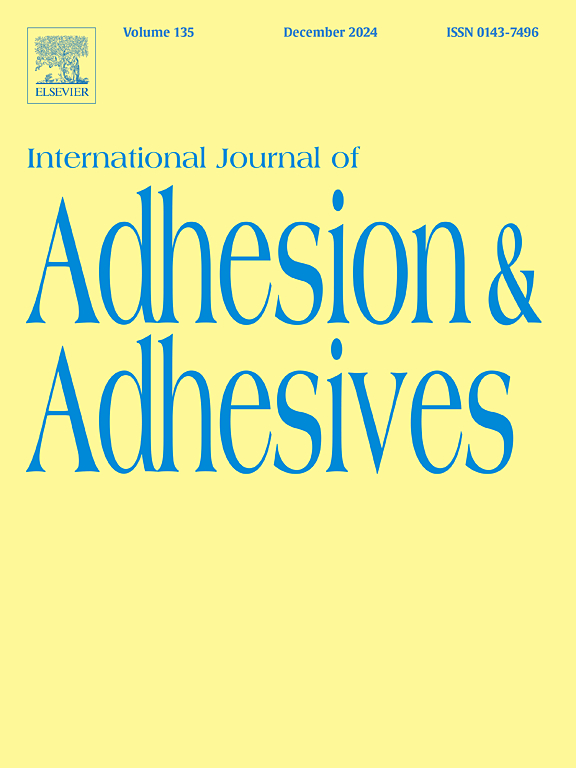石墨烯基增强修复材料的键合行为:系统综述和荟萃分析
IF 3.5
3区 材料科学
Q2 ENGINEERING, CHEMICAL
International Journal of Adhesion and Adhesives
Pub Date : 2025-05-13
DOI:10.1016/j.ijadhadh.2025.104046
引用次数: 0
摘要
目的研究石墨烯基材料对树脂复合材料中牙本质粘附的影响。方法按照PRISMA声明进行SRM,在PROSPERO (CRD42024614838)中登记。系统检索Medline/Web of Science/Scopus/Embase/Cochrane Library,检索截止到2024年9月发表的文章。符合条件的研究包括评估石墨烯基材料在树脂-牙本质粘附中的使用的体外研究,但没有对照、动物实验、非牙本质实验、仅材料实验或综述的研究除外。采用Rev Man软件提取数据并进行meta分析。采用修改后的乔安娜布里格斯研究所的检查表进行偏倚风险评估。结果在筛选的694份记录中,纳入了9项研究。石墨烯基材料对牙本质的结合强度有明显的改善作用。牙本质剪切结合强度显著增强,特别是在1%时(MD[95% CI] = 2.30[1.88;2.72], P <;0.00001)和2% (MD[95% CI] = 20.41 [7.86;32.95], Р = 0.001),较低浓度0.25% (MD[95% CI] = 3.25 [-8.30;14.79], P = 0.58)的影响最小。微拉伸粘结强度表现出好坏参半的结果,初始粘结强度较低,但随着时间的推移,其性能与传统材料相当。推出键合强度各不相同,一项研究显示键合改善,另一项研究显示没有差异。石墨烯的掺入减少了粘合破坏和内聚破坏,并且一些材料的微泄漏较少。总的来说,这些研究的偏倚风险较低。结论石墨烯基材料在体外增强牙本质黏附和结合强度方面表现良好,在临床应用中具有改善牙本质黏附修复效果的潜力。然而,方案的可变性和有限的长期数据,包括水储存引起的衰老,阻碍了明确的临床结论。未来的研究应集中在标准化方法、评估长期性能和评估生物相容性方面。本文章由计算机程序翻译,如有差异,请以英文原文为准。

Bonding behavior of graphene-based enhanced restorative materials: a systematic review and meta-analysis
Objective
This systematic review and meta-analysis (SRM) aimed to investigate the efficacy of graphene-based materials on dentin adhesion in resin composites.
Methods
This SRM was conducted following the PRISMA statement and was registered in PROSPERO (CRD42024614838). A systematic search was conducted in Medline/Web of Science/Scopus/Embase/Cochrane Library, for articles published until September 2024. Eligible studies included in vitro studies evaluating the use of graphene-based materials in resin-dentin adhesion, excepting those without controls, on animals, non-dentine-focused, material-only, or reviews. Data were extracted and Meta-analysis was performed using Rev Man software. A modified Joanna Briggs Institute's Checklist was used for risk of bias assessment.
Results
Of the 694 records screened, 9 studies were included. Graphene-based materials exhibited effects on the improvement of bond strength to dentin. Dentin shear bond strength was significantly enhanced, particularly at 1 % (MD[95 % CI] = 2.30[1.88; 2.72], P < 0.00001) and 2 % (MD[95 % CI] = 20.41 [7.86; 32.95], Р = 0.001) concentrations, while lower concentration 0.25 % (MD[95 % CI] = 3.25 [-8.30; 14.79], P = 0.58) had minimal effect. Microtensile bond strength showed mixed results, with lower initial bond strength but comparable performance to conventional materials over time. Push-out bond strength varied, with one study showing improved bonding and another showing no difference. Graphene incorporation reduced adhesive failure and cohesive failure, and some materials exhibited less microleakage. Overall, the studies presented a low risk of bias.
Conclusions
Graphene-based materials have shown promise in enhancing dentin adhesion and bond strength in vitro, suggesting their potential to improve adhesive restoration outcomes in clinical practice. However, variability in protocols and limited long-term data, including aging by water storage, prevent definitive clinical conclusions. Future research should focus on standardizing methods, evaluating long-term performance, and assessing biocompatibility.
求助全文
通过发布文献求助,成功后即可免费获取论文全文。
去求助
来源期刊

International Journal of Adhesion and Adhesives
工程技术-材料科学:综合
CiteScore
6.90
自引率
8.80%
发文量
200
审稿时长
8.3 months
期刊介绍:
The International Journal of Adhesion and Adhesives draws together the many aspects of the science and technology of adhesive materials, from fundamental research and development work to industrial applications. Subject areas covered include: interfacial interactions, surface chemistry, methods of testing, accumulation of test data on physical and mechanical properties, environmental effects, new adhesive materials, sealants, design of bonded joints, and manufacturing technology.
 求助内容:
求助内容: 应助结果提醒方式:
应助结果提醒方式:


